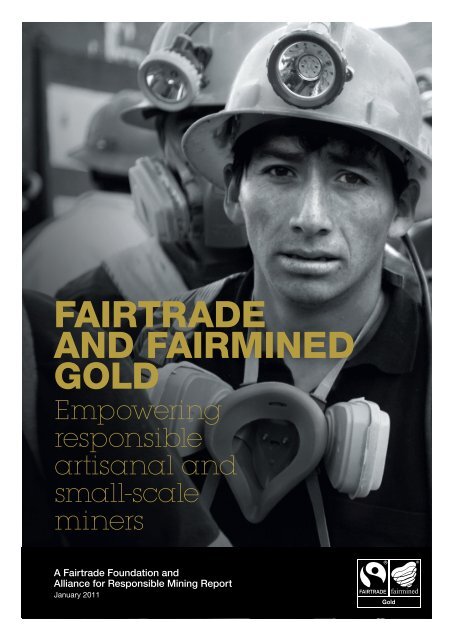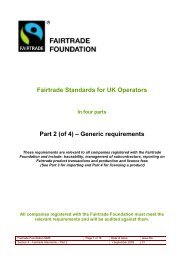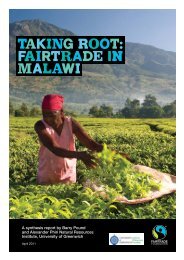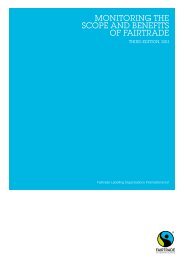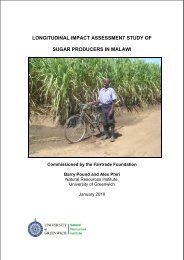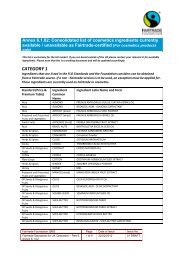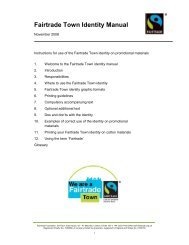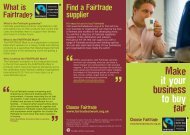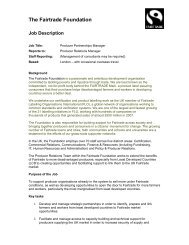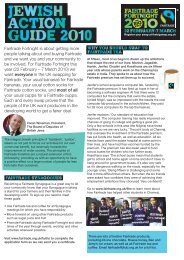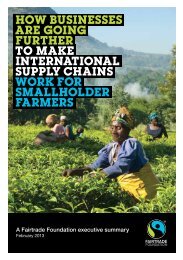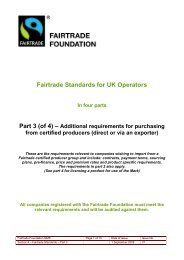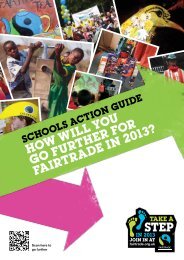FAIRTRADE AND FAIRMINED GOLD - The Fairtrade Foundation
FAIRTRADE AND FAIRMINED GOLD - The Fairtrade Foundation
FAIRTRADE AND FAIRMINED GOLD - The Fairtrade Foundation
You also want an ePaper? Increase the reach of your titles
YUMPU automatically turns print PDFs into web optimized ePapers that Google loves.
<strong>FAIRTRADE</strong><br />
<strong>AND</strong> <strong>FAIRMINED</strong><br />
<strong>GOLD</strong><br />
Empowering<br />
responsible<br />
artisanal and<br />
small-scale<br />
miners<br />
A <strong>Fairtrade</strong> <strong>Foundation</strong> and<br />
Alliance for Responsible Mining Report<br />
January 2011
<strong>GOLD</strong> FACTS<br />
• 100 million people worldwide depend on artisanal and small-scale<br />
mining for survival. 1<br />
• <strong>The</strong>re are around 15 million artisanal and small-scale gold miners<br />
globally, producing some 200-300 tonnes of gold. 2<br />
• Artisanal and small-scale miners account for 10% of the global gold<br />
supply and 90% of the labour force in gold extraction. 3<br />
• Artisanal and small-scale miners are characterised by high levels<br />
of poverty.<br />
• In 2009, 2,575 tonnes of gold were extracted from the earth, which<br />
accounts for 60% of the world’s total gold supply. 1,759 tonnes were<br />
used to make jewellery. 4<br />
• Around 50% of the global demand for gold is for jewellery. 5<br />
• In 2010, $137.5bn (£92bn) was spent on gold jewellery globally. 6<br />
• <strong>The</strong> internationally agreed price of gold is set twice a day by traders<br />
in the City of London.<br />
• <strong>The</strong> price of gold has risen from US$320 in 1999 to over US$1,400 per<br />
ounce in 2010. 7<br />
• For <strong>Fairtrade</strong> and Fairmined gold, miners receive a <strong>Fairtrade</strong><br />
premium of 10% on top of the guaranteed minimum price, which can<br />
be used to invest in their community or business improvement.<br />
• For <strong>Fairtrade</strong> and Fairmined Ecological Gold that has been produced<br />
without the use of chemicals, miners get an extra 5% on top of the<br />
10% <strong>Fairtrade</strong> premium.<br />
ACKNOWLEDGEMENTS<br />
This briefing has been written by Sonya Maldar, and was commissioned by the <strong>Fairtrade</strong> <strong>Foundation</strong> and the<br />
Alliance for Responsible Mining. It has been edited by Gemma Cartwright on behalf of the <strong>Fairtrade</strong> <strong>Foundation</strong> and<br />
Cristina Echavarria for ARM. We would also like to thank the mining organisations who contributed to this briefing.<br />
Photography credits: Eduardo Martino, Ronald de Homell, Samira Pecce, Felix Hruschka<br />
www.fairgold.org<br />
www.fairtrade.org.uk/gold<br />
www.communitymining.org
EXECUTIVE SUMMARY<br />
Gold: symbol of love, power and wealth. But look<br />
behind the glitz and the reality is not so glamorous.<br />
Some 90% of the labour force involved in gold mining<br />
is made up of artisanal and small-scale miners.<br />
Fifteen million men, women and children work in<br />
harsh conditions, doing backbreaking work to scrape<br />
a living. <strong>The</strong>y produce 200-300 tonnes of gold each<br />
year, around 10% of the global gold supply. Exploited<br />
by some middle men, their access to markets is<br />
limited and they rarely receive a fair price for<br />
their product.<br />
<strong>The</strong> poor and vulnerable in Africa, Asia and Latin<br />
America are driven into artisanal mining because it<br />
can offer an alternative way to earn a living where<br />
agriculture or other activities are simply not viable.<br />
However, they face a multitude of challenges as they<br />
struggle to survive. <strong>The</strong> current increase in gold prices<br />
is driving millions more into this sector.<br />
Most mining laws are geared towards large-scale<br />
industrial mining and governments tend to give the<br />
large-scale industry preferential mining rights. This<br />
increases the vulnerability of small-scale miners who<br />
find it hard to access legal mining rights, pushing<br />
them into running informal and illegal operations.<br />
Working conditions are hazardous and health and<br />
safety measures insufficient. <strong>The</strong> unskilled handling of<br />
toxic chemicals such as mercury and cyanide poses<br />
severe risks to miners, their communities and the<br />
natural environment.<br />
If that wasn’t tough enough, artisanal and small-scale<br />
miners are at the sharp end of a long and complex<br />
supply chain over which they have little control.<br />
Tracing gold from buyer to jewellery manufacturer to<br />
refiner is notoriously difficult and the gold industry<br />
has been slow to open its doors to scrutiny. This<br />
lack of transparency makes it virtually impossible for<br />
consumers to know where and under what conditions<br />
the gold in their jewellery was mined.<br />
<strong>The</strong> international <strong>Fairtrade</strong> movement and the Alliance<br />
for Responsible Mining (ARM) are working together<br />
to bring to market the first ever <strong>Fairtrade</strong> and<br />
Fairmined certified gold jewellery. As consumers<br />
become increasingly concerned about the<br />
conditions in which precious metals are mined,<br />
this groundbreaking initiative offers a lifeline to<br />
economically disadvantaged artisanal miners and<br />
their communities.<br />
FLO and ARM have developed a set of clearly defined<br />
standards for responsible mining, which must be<br />
met by mining organisations to achieve <strong>Fairtrade</strong><br />
and Fairmined certification. <strong>The</strong> standards are based<br />
on ARM’s Standard Zero, and were tested with nine<br />
miners’ organisations in Bolivia, Colombia, Ecuador<br />
and Peru, in a process that has helped them to<br />
formalise and improve their mining and business<br />
practices. <strong>The</strong> standard is open to organisations in<br />
Latin America, and work is already underway to expand<br />
the initiative to Africa and Asia in the near future.<br />
Miners’ groups are proof that with training it is possible<br />
to meet strict standards on working conditions, child<br />
labour, women’s rights, cleaner technology, health and<br />
safety, management of chemicals and responsibility to<br />
the environment before the gold they produce can be<br />
certified as <strong>Fairtrade</strong> and Fairmined.<br />
In return, the miners gain market access and receive<br />
a <strong>Fairtrade</strong> premium equivalent to 10% of the<br />
internationally agreed price of gold, which must be used<br />
to improve their business or for community development<br />
projects. Those miners’ organisations that produce their<br />
gold without the use of mercury or cyanide can earn an<br />
additional ecological premium of 5% to recognise the<br />
additional costs involved in using cleaner technology.<br />
Through these fully transparent and traceable supply<br />
chains, consumers and retailers can have confidence<br />
that artisanal and small-scale miners are getting a fair<br />
deal and responsible mining practices have been used.<br />
But this is just the start of the journey. <strong>Fairtrade</strong> and<br />
Fairmined certified gold has the potential to enable<br />
thousands more artisanal miners to escape from unfair<br />
supply chains and dangerous working conditions. Although<br />
even the most marginalised miners have improved their<br />
profit margins and revenues due to the increasing price<br />
of gold, many artisanal and small-scale miners are still<br />
vulnerable as they are unable to access the enormous profits<br />
being made on gold further up complex supply chains.<br />
Expanding the support to miners’ organisations so that<br />
they can achieve <strong>Fairtrade</strong> and Fairmined certification<br />
and encouraging more retailers to stock <strong>Fairtrade</strong><br />
and Fairmined gold are vital next steps. However,<br />
governments must also help artisanal and small-scale<br />
mining organisations to gain access to legal mining<br />
rights and create sound laws to govern and support a<br />
sustainable artisanal and small-scale mining (ASM) sector.<br />
<strong>Fairtrade</strong> and Fairmined gold: Empowering responsible artisanal and small-scale miners 3
1. ALL THAT GLITTERS?<br />
THE <strong>GOLD</strong> JEWELLERY<br />
INDUSTRY<br />
<strong>The</strong> global jewellery market is big<br />
business. Of the 2,300 tonnes of gold<br />
extracted from the earth in 2009,<br />
1,750 tonnes were<br />
used to make<br />
jewellery. This<br />
equates to just over<br />
70% of the global<br />
demand for newly<br />
mined gold, with<br />
the remaining 30%<br />
used for investment,<br />
dentistry and<br />
electronic goods. 8<br />
A staggering $137.5bn (£92bn) was spent on gold<br />
jewellery in 2010, making it one of the world’s largest<br />
categories of consumer goods. India and the Middle<br />
East are amongst the biggest consumers of gold<br />
jewellery, with other substantial markets in China<br />
and the USA. 9<br />
<strong>The</strong> UK is the second largest market for gold jewellery<br />
in Europe after Italy where the most popular items<br />
purchased are earings, rings and necklaces. 10 In 2005<br />
this represented 19 million jewellery items which were<br />
hallmarked as gold. 11 Yet despite the public’s fascination<br />
with gold, it is only in recent years that shoppers have<br />
started to take an interest in where their jewellery<br />
comes from and who is involved in its manufacture.<br />
In the late 1990s and early 2000s, brutal conflicts in<br />
Angola, Sierra Leone and Liberia, fuelled by trade in socalled<br />
blood diamonds, cast a spotlight on the jewellery<br />
industry. Hard-hitting NGO campaigns exposed<br />
the link between the diamond trade and the death<br />
and displacement of millions of people in Africa and<br />
consumers started to demand conflict-free jewellery. 12<br />
In 2003 the international diamond certification scheme<br />
known as the Kimberley Process was established to<br />
help prevent the trade in conflict diamonds. 13<br />
It is only more recently that there has been focus on<br />
the impacts of gold mining on the developing world.<br />
NGO campaigns have exposed some of the social<br />
and environmental problems caused by the large-<br />
4 <strong>Fairtrade</strong> and Fairmined gold: Empowering responsible artisanal and small-scale miners<br />
scale mining industry, for example, CAFOD’s Unearth<br />
Justice campaign in the UK and the No Dirty Gold<br />
campaign in the USA. 14 Large-scale mine disasters<br />
such as the pollution of the Baia Mare River by the<br />
Aural Gold Processing Plant in Romania 15 as well<br />
as evidence showing how gold mining was funding<br />
conflict in the Democratic Republic of Congo caused<br />
further concern amongst the general public. 16 It was at<br />
this time ARM began to work with artisanal and smallscale<br />
(ASM) miners to develop Standard Zero which<br />
formed the basis for the <strong>Fairtrade</strong> and Fairmined<br />
Standard for Gold. 17<br />
Consumer concerns about gold have also been<br />
linked to the growing trend for fairly traded or ethically<br />
sourced products. A CAFOD poll conducted as far<br />
back as 2006 revealed this shift in consumer opinion.<br />
Of those polled, a third of respondents said they<br />
would choose to shop at stores that were concerned<br />
about how their gold is produced, while a quarter said<br />
they would buy <strong>Fairtrade</strong> and Fairmined gold even<br />
if meant paying more. 18 More recently, the <strong>Fairtrade</strong><br />
<strong>Foundation</strong>’s own research shows that consumers<br />
believe buying jewellery for a special occasion would<br />
hold greater value and significance if it carried the<br />
<strong>Fairtrade</strong> and Fairmined dual label. 19<br />
In response to these shifts in public opinion, a number<br />
of initiatives are seeking to address concerns about<br />
practices within the large-scale gold mining industry,<br />
for example the Responsible Jewellery Council and<br />
the Initiative for Responsible Mining Assurance. 20<br />
However, because of the complexity and opacity<br />
of the gold supply chain (see section 3) it has been<br />
difficult to get the industry to change its ways and<br />
progress has been slow. It is also significant that<br />
none of these initiatives address the challenges of<br />
the artisanal and small-scale mining sector, excluding<br />
millions of miners worldwide who make up the<br />
majority of the mining workforce.<br />
From 2005 to 2009, 32% of the global gold supply<br />
came from recycled sources. 21 Although recycling is<br />
a good way of reducing the environmental impacts<br />
of mining, only 30% of the market for gold can be<br />
satisfied from such sources. <strong>Fairtrade</strong> and Fairmined<br />
certified gold will provide direct developmental<br />
impacts for ASM miners, who could take up other<br />
informal exploitative activities such as involvement in<br />
the drug or sex trades.
2. ARTISANAL <strong>AND</strong> SMALL-<br />
SCALE <strong>GOLD</strong> MINING: THE FACTS<br />
ASM is a global phenomenon occurring in at least 70 countries in Africa,<br />
Asia and Latin America. 22<br />
MAP SHOWING THE LOCATION OF ASM<br />
Estimated no. ASM<br />
per country<br />
5,000 – 50,000<br />
50,000 – 150,000<br />
150,000 – 300,000<br />
300,000 – 500,000<br />
500,000 – 2,000,000<br />
An artisanal and small-scale miner is self employed,<br />
but can also be an employee, working as an individual<br />
or in a family unit linked to a local community, mining<br />
group, co-operative, or ASM organisation. Those<br />
involved are usually poor, vulnerable men, women and<br />
children driven to artisanal mining for survival.<br />
ASM can be considered as a pyramid, where new<br />
individual miners and families enter daily at the<br />
bottom, and either scavenge for a time and then<br />
leave, or become settled and organised, and start<br />
climbing the ladder towards small-scale mining at<br />
the top.<br />
A key feature of artisanal mining is high labour<br />
intensity and low capital investment, in comparison to<br />
the large-scale industry which is highly mechanised.<br />
It is mostly informal and unregulated, with miners<br />
employing rudimentary tools and equipment to mine<br />
Source: CASM<br />
and process the gold. ASM is sometimes an illegal<br />
activity as miners do not necessarily have rights to<br />
mine in the area.<br />
However, if miners are able to organise and reinvest<br />
they can move into the small-scale mining category,<br />
which is legally recognised, more mechanised, more<br />
organised and more formal, allowing miners to work<br />
over a larger and deeper area, and earn a decent living. 23<br />
<strong>The</strong> mostly informal nature of ASM makes it<br />
impossible to know the exact number of people<br />
involved. In 1999 the ILO estimated that there were<br />
13 million artisanal and small-scale miners, and 100<br />
million who depended directly and indirectly on ASM<br />
for their livelihood. 24 <strong>The</strong> rise in gold prices today<br />
(from US$320 in 1999 to over US$1,400 per ounce in<br />
2010) means that the number of people depending on<br />
ASM activity to survive has dramatically increased. 25<br />
<strong>Fairtrade</strong> and Fairmined gold: Empowering responsible artisanal and small-scale miners 5
GBP<br />
High value minerals such as gold and gemstones are<br />
the predominant commodities extracted by artisanal<br />
and small-scale miners. Silver and in rare cases<br />
platinum may also be a by-product of gold mining.<br />
<strong>The</strong>re are currently around 15 million artisanal gold<br />
30,000<br />
25,000<br />
20,000<br />
15,000<br />
10,000<br />
5,000<br />
SIZE MATTERS:<br />
the difference between large- and small-scale mining<br />
10km<br />
Source: Gold from ASM : What is it? Felix Hruschka<br />
Not ASM<br />
Large-scale mining accounts for the majority of the world’s gold supplies, but just 10% of the labour<br />
force. It is typically very capital intensive with substantial investments in plant and infrastructure taking<br />
place. Large-scale mines typically take several years to build and commission, and depending on<br />
their size can cost hundreds of millions of dollars. <strong>The</strong>y are often managed by listed companies, or<br />
state-owned mining companies. Large-scale hard rock mining is usually open pit and brings great<br />
environmental damage. Although the social and environmental performance of the largest gold mining<br />
companies has improved in recent years, there are still cases of human rights abuse and environmental<br />
pollution linked to the large-scale industry today. 26<br />
RISING PRICE OF <strong>GOLD</strong><br />
2000 2001 2002 2003 2004 2005 2006 2007 2008 2009 2010<br />
Source: Data reproduced by kind permission of the London Gold Market Fix Ltd.<br />
6 <strong>Fairtrade</strong> and Fairmined gold: Empowering responsible artisanal and small-scale miners<br />
100m<br />
ASM<br />
miners globally, producing some 200-300 tonnes of<br />
gold. 27 So although artisanal and small-scale miners<br />
produce just 10% of the world’s gold supply, it is<br />
estimated that they account for 90% of the labour in<br />
gold extraction. 28<br />
Avg annual LBMA<br />
PM fix £/Kg
2.1 HOW THE<br />
<strong>GOLD</strong> IS MINED<br />
<strong>AND</strong> PROCESSED<br />
Gold mining methods vary according to the geology<br />
of the area where the gold deposit is found. Different<br />
types of mineral deposits are found in riverbeds, flood<br />
plains and areas where there are small veins of gold in<br />
the rock, as well as mines and mine waste known as<br />
tailings abandoned by large-scale companies.<br />
<strong>The</strong> gold found in riverbeds is known as alluvial<br />
gold and is usually easier to harvest directly from<br />
the surface with basic tools, such as spades and<br />
pans, or from old river terraces by removing vegetation<br />
or digging pits to the gold bearing beds. Tailings,<br />
containing small concentrations of gold left by large<br />
mining companies, are mined in a similar manner.<br />
Processing often takes place on site, on the same day,<br />
in order to generate much-needed income quickly.<br />
Miners of alluvial gold tend to be transient, combining<br />
mining with other economic activities depending<br />
on the season and the opportunities in other<br />
sectors such as agriculture. Alluvial gold deposits<br />
are especially vulnerable to rush mining when gold<br />
prices rocket, attracting rich and poor and creating<br />
enormous challenges for responsible and stable<br />
alluvial mining communities, such as the Oro Verde<br />
miners in Colombia.<br />
In the case of hard-rock mining, which takes place<br />
underground, larger capital investment is required<br />
for tools, explosives and equipment to dig tunnels,<br />
remove the rock which contains gold (known as ore)<br />
and to pump oxygen underground. In this case the<br />
ore is extracted underground and processed on the<br />
surface, often over several days or weeks. <strong>The</strong>se<br />
miners tend to settle, forming villages and generating<br />
dynamic local economies.<br />
<strong>The</strong> ore goes through several stages of processing<br />
to extract the gold. First it is crushed, milled and<br />
ground. This can be done by manual crushing (often<br />
the work of women) or mechanised crushing and<br />
milling, or a combination. <strong>The</strong> finer the powder, the<br />
more gold is recovered.<br />
Next the ore is concentrated into a gold rich mineral.<br />
This is done by gravity separation using sluice boxes,<br />
shaking tables and simple pans. Most commonly,<br />
the concentrate is then mixed with mercury, which<br />
captures the gold to form a mixture known as<br />
amalgam. <strong>The</strong> amalgam is heated to evaporate the<br />
mercury, leaving residual gold and other metals.<br />
Finally, the residual gold is melted down to remove<br />
excess mercury. At this stage, the purity of the gold<br />
may vary from 70% to 90%, since it is still mixed with<br />
silver and other metals. This semi-pure gold is known<br />
as doré.<br />
Some small-scale miners use cyanide leaching as an<br />
alternative to mercury processing. Here, a cyanide<br />
solution is used to leach the gold from the crushed<br />
ore, by dissolving it into a gold-rich liquid. <strong>The</strong> still<br />
semi-pure gold is then recovered from the solution<br />
using zinc or activated carbon.<br />
As using cyanide requires substantial investment,<br />
special training, a longer processing time, and<br />
significant financial capacity, it is less widely used<br />
by artisanal and small-scale miners. However when<br />
used properly, cyanidation enables miners to<br />
eliminate mercury completely and increase their<br />
gold recovery rates. 29<br />
Extracting ore Milling the ore Cyanidation pit<br />
<strong>Fairtrade</strong> and Fairmined gold: Empowering responsible artisanal and small-scale miners 7
3. FROM MINE TO SHOP:<br />
THE <strong>GOLD</strong> SUPPLY CHAIN<br />
Extracting the gold from the earth and processing it<br />
are just the first steps in a long and complex supply<br />
chain. Artisanal miners never sell their gold to end<br />
retailers and it may change hands several times<br />
before it leaves the country for export. 30 Typically,<br />
miners sell their gold to a buyer in the nearest town or<br />
a buyer’s agent who comes to the mine site.<br />
It may go through further traders before it is exported.<br />
Either in country before export or once imported the<br />
semi-pure gold, or doré, is refined into gold bullion<br />
to a purity of a minimum of 99.5% and sold on the<br />
international markets.<br />
London may be a world away from the average<br />
artisanal miner, but it plays an influential role in the<br />
global gold market. London is also the place where<br />
billions of dollars in gold bullion is traded.<br />
One of the most powerful players in the gold market is<br />
the London Bullion Market Association (LBMA). This<br />
is the London-based trade association that represents<br />
the wholesale market for gold and silver in London<br />
and, importantly, sets the world price for gold. <strong>The</strong><br />
London Gold Fix (or LBMA fix) as it is known, is set<br />
twice a day and is the global price reference for gold<br />
trading worldwide. <strong>The</strong>se decisions, taken by traders<br />
in the City of London, have a major impact on the<br />
lives of artisanal miners, thousands of miles across<br />
the world. Gold bullion is invested in by not only<br />
MINER<br />
FROM MINE TO SHOP – THE <strong>GOLD</strong><br />
JEWELLERY SUPPLY CHAIN<br />
RETAILER<br />
ONSITE BUYER<br />
MANUFACTURER<br />
8 <strong>Fairtrade</strong> and Fairmined gold: Empowering responsible artisanal and small-scale miners<br />
financial organisations but also individuals. <strong>The</strong>re has<br />
been a large increase in the investment potential of<br />
gold since the recent economic crisis as its value has<br />
continued to increase.<br />
From bullion dealers or investment banks the gold is<br />
sold to a manufacturer. Here it is alloyed with other<br />
metals and manufactured into metal sheets, wire or<br />
granules before finally being crafted into jewellery.<br />
<strong>The</strong> traditional structure of the supply chain means<br />
that gold from several sources may be refined in the<br />
same batch, and it has been historically impossible<br />
for consumers to know where the gold in an item of<br />
jewellery was mined. 31 In recent years there have been<br />
calls for increased transparency in the global gold<br />
industry. This pressure has come from NGOs and<br />
consumers who want to be sure that the gold they<br />
are buying has not caused harm to communities or<br />
the environment.<br />
REGIONAL<br />
BUYER<br />
BULLION<br />
DEALER/<br />
INVESTMENT<br />
BANK<br />
REFINER<br />
INTERNATIONAL<br />
TRADER<br />
EXPORTER<br />
Source: ARM
4. BETWEEN A ROCK <strong>AND</strong> A<br />
HARD PLACE: THE LIFE OF AN<br />
ARTISANAL MINER<br />
‘IT’S NOT<br />
EASY TO<br />
BE AN<br />
ARTISANAL<br />
MINER, IT’S<br />
VERY HARD.<br />
IT’S A VERY<br />
DEM<strong>AND</strong>ING<br />
JOB.’<br />
Manuel Reinoso Rivas,<br />
President SONAMIPE<br />
(Peruvian National Smallscale<br />
Mining Association)<br />
Artisanal and small-scale miners are highly vulnerable.<br />
Driven into mining because of lack of alternative<br />
livelihoods, they work in backbreaking conditions, with<br />
little legal protection. Mining communities lack basic<br />
sanitation, clean and safe drinking water and have little<br />
or no access to health and education services.<br />
4.1 ACCESS TO LEGAL<br />
MINING RIGHTS<br />
One of the major challenges for artisanal and smallscale<br />
miners is gaining access to legal mining<br />
rights. Mineral laws are usually designed for largescale,<br />
industrial mining and rarely are artisanal and<br />
small-scale miners capable of meeting the legal<br />
requirements for the large-scale sector. 32<br />
<strong>The</strong> difficulty in getting legal mineral rights means that<br />
most ASM is informal or illegal. While some countries,<br />
such as Peru and Tanzania, have explicit legislation<br />
for ASM, in the majority of places the informality<br />
of ASM leaves miners vulnerable to exploitation by<br />
middlemen and lack of regulation.<br />
4.2 DANGEROUS<br />
WORKING CONDITIONS<br />
Mining is a high risk activity and miners face a<br />
multitude of hazards everyday. Due to the informal<br />
nature of ASM and the lack of capital investment,<br />
most miners are poorly trained, don’t use protective<br />
gear and use only rudimentary equipment. According<br />
to the International Labour Organisation there are<br />
six to seven times as many non-fatal accidents in<br />
ASM compared to large-scale mining. 33 This is mainly<br />
because in ASM there is a larger labour force and<br />
poorer working conditions. Per kilogram of gold<br />
produced however ASM miners suffer less fatalities<br />
than occur in large-scale mining. <strong>The</strong> most common<br />
causes of accidents are rock falls, ground collapse,<br />
‘Treatment for even the most basic<br />
ailments is hampered by many<br />
mining communities’ lack of access<br />
to medical facilities.’<br />
<strong>Fairtrade</strong> and Fairmined gold: Empowering responsible artisanal and small-scale miners 9
shaft collapse, landslides, faulty machinery and<br />
explosive accidents. Poor lighting, ventilation, dust<br />
inhalation and noise pollution can lead to health<br />
problems, such as silicosis. 34<br />
<strong>The</strong>re are severe risks to health from daily contact<br />
with the toxic chemicals used to process the<br />
gold, such as mercury, cyanide and nitric acid.<br />
Exposure to mercury vapours and ingestion from<br />
contaminated water and food can lead to colic,<br />
vomiting, gastroenteritis, kidney complaints, muscular<br />
tremors and ulceration of gums. Chronic mercury<br />
poisoning can result in speech disturbances, lack<br />
of concentration, depression, muscular atrophy and<br />
seizures. 35 Treatment for even the most basic ailments<br />
is hampered by many mining communities’ lack of<br />
access to medical facilities.<br />
Jenny Torres Delgado is 27 years old and has<br />
lived in Santa Filomena, Peru for most of her life.<br />
She has two children, a girl of five and a boy<br />
of three.<br />
‘My parents work here. My whole family lives here.<br />
I’ve been a ‘pallaquera’ (woman miner) for two<br />
years, that’s all. Well, ‘pallaqueras’ are women<br />
(sometimes also older men and adolescents)<br />
who collect the small stones that are left over<br />
after the rocks have been broken up. We collect<br />
these stones and sometimes we sell them or<br />
sometimes we grind them and that’s virtually<br />
what we live off, that’s to say, how we feed our<br />
families [….] We’re working in this environment<br />
all day and all the time we’re working here, we’re<br />
breathing in dust, feeling tired, and sometimes<br />
we suffer with our ovaries because of the weight,<br />
and also there’s the stones which fall onto our<br />
knees. Above all, though, it’s the dust, and also<br />
the weight when lifting up the stones.’<br />
10 <strong>Fairtrade</strong> and Fairmined gold: Empowering responsible artisanal and small-scale miners<br />
4.3 MARKET ACCESS<br />
<strong>AND</strong> UNFAIR SUPPLY<br />
CHAINS<br />
‘It’s very difficult for us to save<br />
because we have to pay for the<br />
children’s education, housing, food,<br />
healthcare... and so it’s not possible to<br />
save. <strong>The</strong> price of gold fluctuates too<br />
much and very often, after a 60 day<br />
shift, there’s not even enough money<br />
for food. Sometimes the gold isn’t pure<br />
and it’s not worth very much.’<br />
Victor Juan Hurtado Padella, Deputy Mayor of Santa<br />
Filomena, Peru<br />
Not only do artisanal miners work in dangerous<br />
conditions, they are at the mercy of unbalanced<br />
markets and unfair supply chains. A major problem<br />
for miners is securing a fair price for their gold.<br />
Although the miners often know the price of gold as<br />
it is traded on international markets, they receive far<br />
less because of the number of middlemen involved.<br />
Buyers commonly pay below the market value, can<br />
act as cartels and fix prices, or cheat miners on the<br />
weight and purity of the gold content. A miner who is<br />
not part of an organised mining group may typically<br />
receive only a small proportion of the internationally<br />
agreed price of gold.<br />
Most miners sell at the mine site, to maximise<br />
the time spent mining, and in small volumes,<br />
usually at the end of the day because they<br />
have immediate needs. This prevents them taking<br />
advantage of higher prices offered for larger<br />
volumes of gold.
Artisanal and small-scale miners find it hard to access<br />
formal credit from banks as they generally lack assets, and<br />
often do not own a mining title for the area they mine, to<br />
use as collateral for loans. <strong>The</strong>y are often forced to seek<br />
loans from their buyers. Rates for loans can be extortionate<br />
and many miners end up in a state of debt bondage. 36<br />
4.4 ENVIRONMENTAL<br />
CONCERNS<br />
Toxic chemicals have an impact on the environment<br />
as well as the health of miners. Most artisanal and<br />
small-scale miners lack awareness or knowledge<br />
about the environmental impacts of their activity;<br />
subsistence is their main concern. 37<br />
Some 650-1,000 tonnes of mercury are released into the<br />
environment per year as a result of poor mining practice.<br />
Artisanal mining is one of the largest sources of mercury<br />
pollution in the world. 38 This has a devastating impact<br />
on surrounding ecosystems and human health.<br />
Other common problems at ASM sites are dumping<br />
and leaking of mine waste into water systems; siltation<br />
of rivers; forest clearance and soil erosion. 39<br />
Encouraging the substitution of mercury is a challenge<br />
because it is a cheap, easy and effective way to<br />
extract gold from ore. It is easily accessible to poor<br />
artisanal and small-scale miners and can be used<br />
independently, by individual miners working alone. 40<br />
Alternative methods such as cyanide leaching are<br />
costly and require a reliable power supply, which<br />
most mining communities lack. Safe cyanide use<br />
requires training and investment in safe installations,<br />
larger volumes of mineral, longer processing time and<br />
highly qualified operators, making this unrealistic for<br />
the majority of subsistence artisanal and small-scale<br />
miners, but better than mercury for more organised,<br />
formalised small-scale miners. 41<br />
5. <strong>FAIRTRADE</strong> <strong>AND</strong> <strong>FAIRMINED</strong><br />
<strong>GOLD</strong>: WHAT IT MEANS<br />
‘Looking into the future, I think this<br />
project can be one of the bases for<br />
the continuous development of our<br />
Chocó communities.’<br />
Américo Mosquera, Oro Verde miner, Colombia<br />
<strong>Fairtrade</strong> and Fairmined gold is about creating<br />
opportunities for economically disadvantaged<br />
artisanal miners and their communities. <strong>Fairtrade</strong><br />
and Fairmined certification is a result of two<br />
organisations, <strong>Fairtrade</strong> International (FLO) and the<br />
Alliance for Responsible Mining (ARM), combining<br />
their expertise to enable small-scale and artisanal<br />
miners to improve their livelihoods. <strong>The</strong> <strong>Fairtrade</strong><br />
<strong>Foundation</strong> is the UK member of FLO which together<br />
with ARM has pioneered <strong>Fairtrade</strong> and Fairmined<br />
gold and the story behind it.<br />
‘You take (the gold) to town to sell and<br />
you get paid very little. If you take it<br />
to Oro Verde you get paid more.’<br />
Nubia Mosquera, woman miner,<br />
Oro Verde project, Colombia 42<br />
VISION FOR<br />
RESPONSIBLE ASM<br />
Our vision is for ASM to become a formalised,<br />
organised and profitable activity that uses efficient<br />
technologies, and is socially and environmentally<br />
responsible, that increasingly develops within<br />
a framework of good governance, legality,<br />
participation and respect for diversity, it increases its<br />
contribution to the generation of decent work, local<br />
development, poverty reduction and social peace in<br />
our nations, driven by a growing consumer demand<br />
for sustainable minerals and ethical jewellery.<br />
<strong>Fairtrade</strong> and Fairmined gold: Empowering responsible artisanal and small-scale miners 11
<strong>FAIRTRADE</strong><br />
INTERNATIONAL (FLO)<br />
& FLO-CERT<br />
<strong>Fairtrade</strong> International (FLO) is the nonprofit<br />
international organisation comprising<br />
the <strong>Fairtrade</strong> <strong>Foundation</strong> and 24 member<br />
organisations in producer and consumer<br />
countries. <strong>Fairtrade</strong> International (FLO) is<br />
responsible for developing <strong>Fairtrade</strong> standards,<br />
providing producer support and managing<br />
producer and trader registers.<br />
FLO-CERT is an independent international<br />
certification company who audit and<br />
independently certify producers and miners<br />
against <strong>Fairtrade</strong> and Fairmined standards.<br />
THE ALLIANCE<br />
FOR RESPONSIBLE<br />
MINING (ARM)<br />
ARM is an international multi-stakeholder<br />
initiative created to enhance equity and<br />
wellbeing in ASM communities. Working with<br />
miners and NGOs, ARM developed the original<br />
Standard Zero upon which ARM and FLO<br />
later developed the <strong>Fairtrade</strong> and Fairmined<br />
Standard for Gold. Through both site-based and<br />
product certification, and corresponding market<br />
incentives, ARM supports ASM organisations<br />
and communities to meet criteria for responsible<br />
social, labour, environmental, and trading<br />
practices, and does advocacy work with<br />
governments for improved rights for ASM miners.<br />
FLO and ARM have created a set of clearly defined<br />
standards which must be fulfilled by miners’<br />
organisations to achieve certification. <strong>The</strong> standards<br />
cover issues such as working conditions, technology,<br />
health and safety, women miners and child labour,<br />
management of chemicals and responsibility to the<br />
environment and the local community. 43<br />
Only community-based artisanal and small-scale miners’<br />
organisations, composed of self-employed miners who are<br />
members, shareholders, or production partners of the<br />
mining organisation, or small entrepreneurs with contracted<br />
labour, can apply for <strong>Fairtrade</strong> and Fairmined certification.<br />
<strong>The</strong> organisation must be legally entitled to mine and is<br />
responsible for all mining activities within its mining area.<br />
Mining organisations are audited by the independent<br />
international certification body FLO-CERT to ensure they<br />
are complying with the standards. Certified gold is co-<br />
12 <strong>Fairtrade</strong> and Fairmined gold: Empowering responsible artisanal and small-scale miners<br />
labelled bearing both the <strong>FAIRTRADE</strong> Certification Mark<br />
and Fairmined Mark. It is the first ever independently<br />
certified fairly traded gold for the jewellery market.<br />
5.1 <strong>FAIRTRADE</strong><br />
<strong>AND</strong> <strong>FAIRMINED</strong>:<br />
A BETTER DEAL FOR<br />
MINERS<br />
Like producer organisations certified for other<br />
<strong>Fairtrade</strong> products, mining organisations and their<br />
communities are guaranteed a better deal. Miners<br />
get market access and a fair price for their gold, with<br />
increased security of the <strong>Fairtrade</strong> premium.<br />
<strong>The</strong> <strong>Fairtrade</strong> minimum price for the pure gold<br />
content in unrefined gold is set at 95% of the<br />
London Bullion Market Association’s (LBMA) fix. <strong>The</strong><br />
LBMA fix is the internationally agreed price of gold<br />
as it is traded on the international markets. Certified<br />
miners receive at a minimum, 95% of the LBMA<br />
fix in order to recognise the additional value other<br />
members of the gold supply chain add to the gold.<br />
Even more important than the minimum price to<br />
the miners is the <strong>Fairtrade</strong> premium the miners<br />
receive. This is calculated as 10% of the applicable<br />
LBMA fix, for investment in democratically agreed<br />
economic, social or environmental improvements<br />
of the miners’ choice.<br />
5.2 <strong>FAIRTRADE</strong><br />
<strong>AND</strong> <strong>FAIRMINED</strong>:<br />
RESPONSIBLY MINED<br />
<strong>GOLD</strong><br />
<strong>The</strong> <strong>Fairtrade</strong> and Fairmined dual<br />
label ensures that gold has been<br />
mined, processed and traded in<br />
a fair and responsible manner. 44<br />
This means:<br />
• Strengthened miners’ organisations<br />
Through organisation, the miners’ groups are<br />
strengthened and empowered. <strong>The</strong>y form groups<br />
to give themselves better bargaining power with<br />
traders, to get a fairer return for their produce,<br />
and gain greater control over the jewellery supply<br />
chain. <strong>The</strong>y are required to participate in the social<br />
development of their communities.<br />
• Child labour<br />
Mining is considered to involve the worst forms of<br />
child labour as defined by ILO Convention 182. For<br />
certified miner organisations to be a part of <strong>Fairtrade</strong><br />
and Fairmined, they must meet with ILO and national
egulations in their country. For most, this means children<br />
under 15 years of age should not work in mining and all<br />
persons should be over 18 to work underground.<br />
Under <strong>Fairtrade</strong> and Fairmined, no under 18 year<br />
olds should be employed for any type of work<br />
which could jeopardise their health or safety. Any<br />
under 18s who participate in mining alongside<br />
family members must not do anything which<br />
places them in danger or which impacts on their<br />
schooling, social or physical development.<br />
<strong>Fairtrade</strong> and Fairmined certified mining organisations<br />
are required and supported to eliminate all forms of<br />
child labour within their development plans for the<br />
future and to provide younger workers with access<br />
to training and employment.<br />
• Improved working conditions<br />
<strong>Fairtrade</strong> and Fairmined certification requires<br />
mandatory use of protective gear and health and<br />
safety training for all miners. This means miners are<br />
trained to reduce risk in the workplace and on how<br />
to respond in emergency situations.<br />
• Freedom of association and collective bargaining<br />
Certified miners’ organisations must recognise the<br />
right of all workers to establish and join trade unions<br />
and collectively negotiate their working conditions.<br />
• Responsible use of chemicals<br />
Certified miners must use safe and responsible<br />
practices for management of toxic chemicals in gold<br />
recovery, such as mercury and cyanide. Chemicals<br />
have to be reduced to a minimum, and where<br />
possible eliminated over an agreed time period.<br />
5.3 AN ECOLOGICAL<br />
PREMIUM<br />
Miners can earn an additional ecological premium when<br />
they recover gold through gravity only, without the use<br />
of mercury or cyanide. In addition, they must ensure<br />
minimum ecological disruption and forest restoration from<br />
the outset of new operations. <strong>The</strong> ecological premium<br />
is calculated as 5% of the applicable LBMA fix on top of<br />
the <strong>Fairtrade</strong> premium not only as a reward for producing<br />
gold meeting higher standards, but also partly to recognise<br />
that miners recover less gold by not using chemicals.<br />
5.4 TRACEABILITY OF<br />
THE SUPPLY CHAIN<br />
<strong>Fairtrade</strong> and Fairmined certified gold is unique in<br />
offering the first transparent and traceable supply<br />
chain for artisanal and small-scale gold mining. This<br />
is necessary if consumers and retailers are to have<br />
confidence that the gold in their jewellery has met<br />
the <strong>Fairtrade</strong> and Fairmined standards.<br />
Certified jewellery products will have a dual stamp<br />
which contains the <strong>FAIRTRADE</strong> Mark and the<br />
Fairmined Mark to show the gold has been carefully<br />
extracted by mining organisations that meet the<br />
requirements of the <strong>Fairtrade</strong> and Fairmined gold<br />
CHILD LABOUR<br />
It is common for children to be involved in<br />
artisanal mining to help boost family income.<br />
Due to the lack of childcare facilities in many<br />
remote artisanal mining communities, small<br />
children and babies may accompany parents<br />
to the mining site. Older children may help<br />
with hauling ore, fetching water or breaking<br />
rock. Outside of the family context, orphans<br />
and vulnerable children turn to artisanal mining<br />
as a survival strategy. In some cases they are<br />
contracted into bonded labour.<br />
<strong>The</strong> <strong>Fairtrade</strong> <strong>Foundation</strong> and ARM recognise<br />
that child labour is a reality for many mining<br />
communities. <strong>Fairtrade</strong> and Fairmined<br />
certification will help artisanal mining<br />
organisations work towards the elimination of<br />
child labour within their communities. <strong>Fairtrade</strong><br />
and Fairmined certified mining organisations<br />
must commit to standards which mean children<br />
under 15 years cannot work in mining and must<br />
be over 18 to work underground.<br />
By investing the <strong>Fairtrade</strong> Premium in education<br />
and training, communities can provide alternative<br />
childcare arrangements for working mothers and<br />
education opportunities for young people. In<br />
Santa Filomena, the Nueva Esperanza women<br />
miners association was set up (as part of an<br />
ILO IPEC CARE project) to develop alternative<br />
economic development projects including<br />
setting up a nursery to provide childcare for<br />
women miners. With support from ARM, and<br />
in alliance with SOTRAMI, the men’s company<br />
that owns the mining area, this association<br />
will become certified under the <strong>Fairtrade</strong> and<br />
Fairmined standards. <strong>The</strong> association plans<br />
to use the <strong>Fairtrade</strong> Premium they receive to<br />
employ qualified staff for the nursery.<br />
Working towards certification and receiving<br />
training on ways of keeping children safe from<br />
harm has been key in order for this community<br />
to reduce child labour. <strong>The</strong> community members<br />
at SOTRAMI are proud of their work to decrease<br />
child labour and continue to monitor this closely<br />
within the area they mine.<br />
<strong>Fairtrade</strong> and Fairmined gold: Empowering responsible artisanal and small-scale miners 13
standard. Miners’ organisations, buyers, refiners and<br />
manufacturers are required to have strict internal controls<br />
to ensure that the entire volume of certified gold they<br />
sell under <strong>Fairtrade</strong> and Fairmined terms is traceable.<br />
Certified gold is kept separate from non-certified gold<br />
during processing, refining and manufacturing. This<br />
means that it can be traced from the miner to the shop,<br />
creating a fully transparent supply chain.<br />
MERCURY USE 46<br />
In many cases mercury amalgamation is the only<br />
gold recovery technology available to artisanal<br />
miners. This applies to the average artisanal miner,<br />
who is poor. Working individually or in small teams<br />
as members of an artisanal miners’ organisation the<br />
miner lacks the funds needed to invest in advanced<br />
technologies such as mechanic gravity methods or<br />
cyanide leaching. <strong>The</strong> miner needs to sell their gold<br />
on a daily or weekly basis in order to buy food and<br />
clothing and pay for medical treatment and their<br />
children’s education.<br />
Although elimination of the use of mercury in<br />
responsible artisanal and small-scale gold mining<br />
is an important goal, the total and immediate<br />
elimination of mercury is not a realistic condition<br />
for <strong>Fairtrade</strong> and Fairmined gold. Despite the<br />
human health and environmental risks use of such<br />
chemicals presents, totally eliminating mercury<br />
and cyanide is inefficient from the perspective<br />
of mineral recovery, and if it were included as a<br />
condition, 95% of all ASM would be excluded from<br />
the development opportunity of <strong>Fairtrade</strong>.<br />
Instead the standards set out a process to<br />
support ASM organisations to minimise the use<br />
of mercury over an agreed period of time, through<br />
implementation of responsible practices and<br />
technologies to mitigate and reduce impact on the<br />
environment and human health.<br />
<strong>The</strong> greatest loss of mercury occurs when whole<br />
ore amalgamation is carried out, rather than<br />
reducing the ore to a concentrate, and when<br />
amalgam is burnt without using a device to recover<br />
the mercury (retort or similar equipment).<br />
<strong>The</strong> <strong>Fairtrade</strong> and Fairmined standards require<br />
artisanal miners to use a concentration process<br />
(gravity separation, flotation, hand-sorting) prior<br />
to amalgamation, and makes the use of retorts<br />
or other mercury recovery devices during<br />
amalgam decomposition obligatory. Both<br />
requirements ensure that mercury emissions<br />
are drastically reduced up to 90%. 47<br />
14 <strong>Fairtrade</strong> and Fairmined gold: Empowering responsible artisanal and small-scale miners<br />
In exceptional cases, where the physical traceability<br />
requirements impose disproportionate costs, limiting<br />
access to <strong>Fairtrade</strong> markets for certified miners’<br />
organisations, refiners and manufacturers can apply to<br />
be exempt from physical traceability requirements. 45<br />
Physical traceability for <strong>Fairtrade</strong> ecological gold that<br />
receives the ecological premium is compulsory at<br />
all times.<br />
In addition, an ecological premium is offered<br />
on top of the <strong>Fairtrade</strong> premium for mining<br />
organisations who eliminate mercury and cyanide<br />
altogether using only gravimetric methods for<br />
gold recovery, and develop low impact mining.<br />
CYANIDE USE<br />
Mercury amalgamation is a speedy process that<br />
can be carried out by individuals, while cyanidation<br />
is a slow process that usually requires substantial<br />
investment in the construction of a processing<br />
plant. Artisanal miners in many countries have<br />
proved that amalgamation can be replaced by<br />
cyanidation at their level of production if they<br />
organise, obtain the necessary finance to invest<br />
and start using small processing plants.<br />
As cyanide can be detoxified and is even<br />
biodegradable with exposure to UV light and oxygen,<br />
cyanidation can be less harmful to the environment<br />
than mercury amalgamation when practiced to<br />
strict standards. For many miners’ organisations the<br />
<strong>Fairtrade</strong> premium can provide a unique opportunity<br />
to obtain the funds needed to invest in more<br />
environmentally efficient technologies. 48<br />
Moving the ore to the cyanidation pits<br />
Cyanidation pit
6. WHAT DIFFERENCE HAS<br />
<strong>FAIRTRADE</strong> <strong>AND</strong> <strong>FAIRMINED</strong><br />
CERTIFICATION ALREADY<br />
MADE TO MINERS?<br />
‘Before <strong>Fairtrade</strong> we sold our product,<br />
that is, our gold, to the intermediaries<br />
in the district of Chaparra. We sold<br />
to them using their little scales. We<br />
didn’t know if the scales were correct<br />
or not, we didn’t know our legal rights<br />
or how pure our product was.’<br />
Victor Juan Hurtado Padella, Deputy Major,<br />
Santa Filomena, Peru<br />
‘This project has been of great benefit to<br />
us. As long as we work hard and follow<br />
the guidelines, we obtain food security.’<br />
Américo Mosquera, Oro Verde miner, Colombia<br />
To date, nine miners’ organisations, representing 2,500<br />
miners and their families, are being certified. <strong>The</strong>se miners<br />
were heavily involved in developing and testing the<br />
<strong>Fairtrade</strong> and Fairmined standards. <strong>The</strong> following examples<br />
show the difference <strong>Fairtrade</strong> and Fairmined has already<br />
made and the continuous improvements the groups<br />
are planning once certified products go on sale. <strong>Fairtrade</strong><br />
and Fairmined certification is working to improve the lives<br />
of some 30,000 people from mining communities. All of<br />
the current producer groups are based in Latin America<br />
and applications are open to all ASM organisations in<br />
that continent. More producer organisations are expected<br />
to join in 2011 and beyond. A network of pilots has been<br />
established in Africa with plans for expansion into Asia.<br />
‘Before, we used the mercury to<br />
amalgamate the material inside the<br />
town. We weren’t really aware about<br />
the environment and the harm it<br />
caused. Now, with the training we’ve<br />
had and the prohibitions, we use the<br />
mercury in the correct way, and in<br />
order to do this we’ve created what<br />
we call an industrial zone, dedicated<br />
exclusively to the use of mercury.’<br />
Victor Juan Hurtado Padella, Deputy Mayor,<br />
Santa Filomena, Peru<br />
Oro Verde<br />
SOTRAMI<br />
COLOMBIA<br />
PERU<br />
VENEZULA<br />
BOLIVIA<br />
BRAZIL<br />
Cotapata, La Paz<br />
6.1 THE ORO VERDE PROGRAMME, COLOMBIA 49<br />
‘It is important because you get<br />
paid extra and you also have the<br />
guarantee that they are providing<br />
you with technical assistance. <strong>The</strong>y’re<br />
giving you tips so that you can<br />
improve your activity day by day.’<br />
Américo Mosquera, Oro Verde miner, Colombia 50<br />
<strong>The</strong> Oro Verde programme was established in 2000 to<br />
support ASM by Afro-Colombian communities in the<br />
Chocó region of Colombia. Afro-Colombian communities<br />
are amongst the most marginalised in Colombia.<br />
<strong>The</strong> communities are organised and represented by<br />
Community Councils that govern collective lands within<br />
different municipalities. <strong>The</strong> programme has worked with<br />
over 1,300 artisanal miners since it was established.<br />
Currently 112 family units participate in the programme,<br />
which achieved <strong>Fairtrade</strong> and Fairmined status in 2011.<br />
<strong>The</strong> type of mining carried out by the Oro Verde<br />
producers is alluvial, involving gold panning in rivers<br />
and streams and diving for sediment. No mercury<br />
or cyanide is used to process the gold; instead the<br />
communities employ a range of traditional mining<br />
techniques inherited from their ancestors allowing<br />
them to claim the additional ecological premium<br />
<strong>Fairtrade</strong> and Fairmined gold: Empowering responsible artisanal and small-scale miners 15
for their gold. Care is taken to restore vegetation after<br />
mining to encourage full recovery of the forest terrain.<br />
<strong>The</strong> <strong>Fairtrade</strong> premium the miners will receive can<br />
be invested in the business, such as bringing more<br />
miners into the programme and scaling up production.<br />
<strong>The</strong>y also hope to enhance gold recovery by investing<br />
in improved technology and implement a gender policy<br />
to improve the working conditions and employment<br />
opportunities of women involved in mining. <strong>The</strong> miners<br />
democratically decide how the <strong>Fairtrade</strong> premium is<br />
invested, encouraging them to become key players in<br />
their own community’s development.<br />
<strong>The</strong> Oro Verde programme has been highly successful<br />
in offering Afro-Colombian communities an alternative<br />
to renting land for illegal and uncontrolled mediumscale<br />
mining, which has had devastating impacts<br />
on the local environment. However, Afro-Colombian<br />
communities still face major challenges in protecting<br />
their land rights against external mineral title requests<br />
to explore the region and extract its minerals.<br />
6.2 SOCIEDAD DE<br />
TRABAJADORES<br />
MINEROS S.A.<br />
(SOTRAMI), PERU 51<br />
‘<strong>The</strong>re have been so many changes<br />
since we organised ourselves into<br />
a company.’<br />
Victor Juan Hurtado Padella, Deputy Mayor,<br />
Santa Filomena, Peru<br />
<strong>The</strong> village of Santa Filomena in central Peru was<br />
originally settled in the 1980s by informal miners working<br />
in abandoned mine sites. All mining was done manually<br />
and all processing was with mercury. Amalgamated gold<br />
was burnt in the open air, presenting serious risks to<br />
human health and the environment. Child labour was<br />
a common problem in the mine. People lived in makeshift<br />
houses and the community lacked even the most<br />
basic facilities such as schools or health services.<br />
In 1989 the Sociedad de Trabajadores Mineros S.A.<br />
(SOTRAMI S.A.) was founded as a company so that the<br />
miners could get legal rights to mine. By taking steps to<br />
organise, the miners of Santa Filomena gained confidence<br />
and increased their bargaining power. Today SOTRAMI<br />
is owned by 166 shareholders, has mining permit for<br />
1,000 hectares and a permit to run a processing plant.<br />
Some 88 miners work in two groups run by SOTRAMI. <strong>The</strong><br />
company has contracted five engineers, a metallurgist, an<br />
electro mechanic and chemical engineer to run the mine<br />
and processing plant. SOTRAMI operates an underground<br />
hard-rock mine. Processing is by cyanide leaching in vats<br />
16 <strong>Fairtrade</strong> and Fairmined gold: Empowering responsible artisanal and small-scale miners<br />
with a closed circuit system to prevent release into the<br />
environment. Final processing takes place at plant in the<br />
capital Lima. <strong>The</strong> average yield is 4.6kg of gold per month.<br />
<strong>The</strong> company has taken major strides to improve<br />
technology, with the aim of offering mercury-free<br />
processing to all SOTRAMI miners. Health and safety<br />
guidelines for the safe storage of chemicals are strictly<br />
enforced and the mills and the mercury processing<br />
have been moved away from the settlement area.<br />
A winch has been installed to hoist minerals so that<br />
it is no longer done manually. Pneumatic drilling has<br />
replaced artisanal digging of the ore. Child labour has<br />
been completely eliminated from the mine. All workers<br />
are given occupational medical check ups and<br />
training on health and safety and the environment.<br />
<strong>The</strong>re has been a major transformation in living<br />
conditions in Santa Filomena. <strong>The</strong> village was moved<br />
away from the mine site by SOTRAMI and a grant by<br />
CASM. Although this has already greatly improved<br />
the living conditions and safety for residents they still<br />
have plans to continue to improve their village with<br />
<strong>Fairtrade</strong> premium. Using the <strong>Fairtrade</strong> premium the<br />
community plans to provide electricity and subsidise<br />
health and education for all, to support community<br />
organisation and local authority efforts to improve<br />
living conditions in the village.<br />
Housing on top of the mine entrance before it was moved<br />
<strong>The</strong> village today, away from the mine entrance<br />
6.3 COTAPATA MINING<br />
CO-OPERATIVE, BOLIVIA<br />
Nestled 4,500 metres in the Yungas Cloud Forest,<br />
the Cotapata National Park in Bolivia is home to the<br />
Cotapata Mining Co-operative. This part of Bolivia,<br />
close to the capital of La Paz, has a long history of<br />
mining. In 1991 a group of miners established the<br />
Cotapata Co-operative to formalise their activity and<br />
secure land rights and a mining permit.
<strong>The</strong>re are currently 88<br />
associates who make up the<br />
co-operative. Of these, 43<br />
are active workers. Cotapata<br />
operates underground, hardrock<br />
mining, with the miners<br />
working two-week shifts at<br />
the camp and returning to La<br />
Paz during rest periods. Most<br />
of the families of the miners<br />
live in La Paz so there are no<br />
children at the mine site.<br />
All workers receive a salary of around US$200 per<br />
month, significantly higher than the national average<br />
wage of US$80 per month. This has enabled the<br />
miners to make real improvement to the lives of<br />
their families. Each miner is insured to a value<br />
of US$10,000 providing additional security for<br />
themselves and their families.<br />
Cotapata is respectful of the fact that they operate in<br />
a National Park. Cotapata have mined in the region<br />
6.4 WOMEN MINERS<br />
‘I would ask (the people in the UK) to<br />
understand that when they buy our<br />
gold, they’ll be doing a good thing<br />
and helping many women who work<br />
hard and have to struggle in order to<br />
get the gold.’<br />
Jenny Torres Delgado, 27-year-old miner from Peru.<br />
Despite its masculine image, women are involved<br />
in almost every aspect of artisanal mining and<br />
processing. In Asia, less than 10% of miners are<br />
women, whereas in Latin America the proportion<br />
tends to be around 20%. <strong>The</strong> highest percentage is<br />
in Africa with around 40-50%, although this varies<br />
WOMEN MINERS’<br />
ASSOCIATION NUEVA<br />
ESPERANZA, PERU<br />
<strong>The</strong> Nueva Esperanza miners’ association was<br />
formed by women miners from the town of<br />
Santa Filomena who needed to organise their<br />
work to fit around childcare and other domestic<br />
responsibilities. <strong>The</strong> group has grown from 40 to 180<br />
women since it was established in 2003. <strong>The</strong> women<br />
carry out pallaquero work, collecting and sorting<br />
valuable minerals and waste which is then sold onto<br />
the SOTRAMI company for processing.<br />
since before it was declared a National Park and<br />
have permission from the necessary bodies to mine.<br />
<strong>The</strong>y use a closed-circuit mercury recovery system<br />
which prevents mercury from being released into the<br />
environment. <strong>The</strong>y are also working with a Bolivian<br />
university to construct a safe dam to hold tailings –<br />
the waste left over from mercury processing.<br />
<strong>The</strong> co-operative produces between 2.5 and 3kg<br />
of gold per month, which is transported to La Paz<br />
and sold to traders for refining and export. <strong>The</strong><br />
<strong>Fairtrade</strong> and Fairmined premium will enable<br />
Cotapata to increase revenue through improving<br />
their operations; exporting gold directly thereby<br />
cutting out middlemen; and formalising sales<br />
transactions.<br />
In the future, Cotapata would like to increase the<br />
mineral output of their operation by reducing the loss<br />
of gold during processing. <strong>The</strong>y also hope to improve<br />
housing conditions and health services at the mining<br />
camp and improve working conditions and training<br />
facilities for the miners.<br />
regionally and from site to site. 52 It is most common<br />
for women to be involved in the transport of ore,<br />
supplies and water; manual crushing and grinding;<br />
and scavenging for ore from dumps and tailings. At<br />
many mine sites, women work with young babies tied<br />
to their backs and toddlers at their side. 53<br />
<strong>The</strong> women are organised into two collecting groups<br />
working from 2pm until 6pm each afternoon to fit<br />
around childcare demands. <strong>The</strong> association has a<br />
nursery where women can leave their children while<br />
they work. <strong>The</strong>y use a hand rake to collect<br />
the minerals and must wear safety equipment<br />
while working.<br />
Through the establishment of Nueva Esperanza,<br />
the women miners of Santa Filomena have grown<br />
in confidence and gained economic independence.<br />
<strong>The</strong>y are using the <strong>Fairtrade</strong> premium to set up a<br />
sewing workshop to make the sacks they use to<br />
collect rocks.<br />
<strong>Fairtrade</strong> and Fairmined gold: Empowering responsible artisanal and small-scale miners 17
7. TIPPING THE BALANCE:<br />
SUPPORTING <strong>FAIRTRADE</strong> <strong>AND</strong><br />
<strong>FAIRMINED</strong> <strong>GOLD</strong><br />
<strong>Fairtrade</strong> and Fairmined gold has the potential to<br />
reach thousands more artisanal and small-scale<br />
miners worldwide. Initially launched in the UK, it will<br />
be expanded to other countries from 2011 onwards.<br />
<strong>The</strong> long term vision for <strong>Fairtrade</strong> and Fairmined gold<br />
is to reach 5% of the gold jewellery market over a<br />
15-year period. Governments, retailers and<br />
consumers can help make this a reality.<br />
7.1 RETAILERS<br />
Businesses that source <strong>Fairtrade</strong> and Fairmined<br />
certified products are at the forefront of a growing<br />
movement of consumers looking for reassurance<br />
that the products they have bought have been<br />
manufactured in a sustainable and fair manner.<br />
By actively demonstrating a commitment to fair<br />
sourcing practices, they are acknowledged leaders,<br />
seen to be shaping the supply chains of the future by<br />
their customers and suppliers and wider stakeholders,<br />
including trade bodies and governments. <strong>The</strong>y are<br />
uniquely placed to fulfil the currently untapped<br />
market demand for responsibly mined gold.<br />
7.2 CONSUMERS<br />
One way to ensure the success of <strong>Fairtrade</strong><br />
and Fairmined gold is for consumers to demand<br />
it in the shops. Next time you make a special<br />
purchase, choose <strong>Fairtrade</strong> and Fairmined jewellery<br />
to be sure that artisanal miners are getting a fair deal<br />
and the gold has been mined responsibly. Spread the<br />
word and encourage your local jewellers to stock<br />
<strong>Fairtrade</strong> and Fairmined gold. Find out more on<br />
www.fairtrade.org.uk/gold<br />
18 <strong>Fairtrade</strong> and Fairmined gold: Empowering responsible artisanal and small-scale miners<br />
7.3 GOVERNMENTS<br />
<strong>Fairtrade</strong> and Fairmined certification is one approach<br />
to addressing the challenges of ASM, but ARM are<br />
working with governments to gain more support for<br />
the formalisation of the ASM sector. By introducing<br />
appropriate legislation that is tailored to the needs of<br />
artisanal and small-scale miners, and implementing<br />
public policy and programs for ASM, they will no longer<br />
be forced to operate illegally. Governments in nations<br />
where ASM commonly occurs can also help miners’<br />
groups to secure mining titles so that the potential of<br />
this sector can be fully harnessed to support long term<br />
development goals. By so doing governments will be<br />
taking advantage of the opportunity that responsible<br />
ASM presents to reduce poverty in the developing world.<br />
7.4 SUPPORTING MINERS<br />
ARM and their network of NGOs are leading on the<br />
support work with mining organisations to build their<br />
capacity and reach the requirements to become <strong>Fairtrade</strong><br />
and Fairmined certified. On certification the mining<br />
organisations can still access support from ARM to ensure<br />
they continue to meet the standards and can continue<br />
to improve their mining practices and communities. To<br />
continue this vital work ARM has established a producer<br />
support fund which individuals or organisations can<br />
contribute to at www.communitymining.org<br />
7.5 FURTHER<br />
INFORMATION<br />
To find out more visit either www.fairtrade.org.uk/gold<br />
or www.communitymining.org
GLOSSARY<br />
ARM: <strong>The</strong> Alliance for Responsible Mining, is a<br />
Colombian-based, independent, global-scale, pioneering<br />
initiative established in 2004 to enhance equity and<br />
wellbeing in artisanal and small-scale mining (ASM)<br />
communities through improved social, environmental and<br />
labour practices, good governance and the implementation<br />
of ecosystem restoration practices. ARM is committed<br />
to social justice and environmental responsibility as the<br />
values driving the transformation of ASM.<br />
ASM: Artisanal and small-scale mining<br />
Amalgamation: A method of extracting gold from mined<br />
ore using mercury to create amalgam which is then<br />
decomposed using chemicals, leaving gold.<br />
Bullion: Precious metals in bulk form traded on<br />
commodity markets.<br />
Cyanidation: A process where a cyanide solution is used<br />
to leach the gold from rock, dissolving it into the water. <strong>The</strong><br />
gold is then recovered from the solution using activated<br />
carbon or zinc.<br />
Doré: An impure alloy of gold produced at a mine that will be<br />
refined to a higher purity.<br />
Dual label: <strong>The</strong> dual label demonstrates to the consumer<br />
the partnership between FLO and ARM and clearly indicates<br />
the precious metal (i.e. gold, silver or platinum) is certified<br />
as <strong>Fairtrade</strong> and Fairmined, to avoid misinterpretation that<br />
the gemstone or other metals are certified <strong>Fairtrade</strong> and<br />
Fairmined. This dual label must be used for both consumer<br />
facing packaging materials and any supporting promotional<br />
materials.<br />
Dual stamp: A dual stamp has been created for application<br />
to the certified gold, silver or platinum product. This stamp<br />
is similar in size and method of application to the legally<br />
required hallmarks found on precious metals.<br />
Ecological gold: <strong>The</strong> gold produced by groups with strong<br />
environmental management systems and who are not<br />
using chemicals is known as ecological gold and carries<br />
an additional premium of 5% of the applicable LBMA fix<br />
on top of the <strong>Fairtrade</strong> premium. <strong>The</strong> additional premium<br />
is to recognise the additional costs involved in maintaining<br />
environmental controls, and compensating for lower<br />
recovery rates than when using chemicals.<br />
<strong>Fairtrade</strong> <strong>Foundation</strong>: <strong>The</strong> UK registered charity and<br />
FLO member responsible for licensing use of the <strong>FAIRTRADE</strong><br />
Mark and increasing consumer awareness<br />
and sales of <strong>Fairtrade</strong> products in the UK.<br />
<strong>Fairtrade</strong> International (FLO): <strong>The</strong> international body<br />
comprising the <strong>Fairtrade</strong> <strong>Foundation</strong> and its partner<br />
organisations in producer and consumer countries. FLO<br />
is responsible for developing <strong>Fairtrade</strong> standards and<br />
managing producer and trader registers.<br />
<strong>FAIRTRADE</strong> Certification Mark: This appears on products<br />
meeting <strong>Fairtrade</strong> standards as defined by <strong>Fairtrade</strong><br />
International (FLO). <strong>The</strong> <strong>FAIRTRADE</strong> Mark is a registered<br />
trademark and independent product certification label.<br />
Fairmined Mark: This appears on jewellery and products<br />
that contain <strong>Fairtrade</strong> and Fairmined certified gold. It is a<br />
trademark of the Alliance for Responsible Mining (ARM),<br />
and an independent product certification label.<br />
FLO-CERT: FLO-CERT GmbH is an independent<br />
international certification company offering <strong>Fairtrade</strong><br />
certification services to clients in more than 70 countries.<br />
<strong>The</strong>y assist in the socio-economic development of<br />
producers in the global south and help to foster long-term<br />
relationships and good practice with traders of certified<br />
<strong>Fairtrade</strong> products. FLO-CERT certification provides a<br />
guarantee to consumers of certified <strong>Fairtrade</strong> products that<br />
they are contributing to the socio-economic development<br />
of people through their purchases.<br />
Gravity separation/concentration: A process carried out<br />
to concentrate gold using the difference of specific gravity<br />
of gold and other minerals. Because gold has a higher<br />
gravity than other minerals, it settles faster in water. Gravity<br />
concentration is carried out using pans, sluices, shaking<br />
tables and centrifuges.<br />
LBMA: London Bullion Market Association is the<br />
London-based trade association that represents the<br />
wholesale market for gold and silver in London, and<br />
sets world prices.<br />
LBMA fix: <strong>The</strong> LBMA set a price for gold in the morning and<br />
afternoon. <strong>The</strong>se prices are known as either the LBMA am fix<br />
or LBMA pm fix.<br />
NGO: Non-governmental organisation.<br />
Ore: Mineral (rock or gravel) which contains gold at an<br />
economic concentration (grade) and that is therefore suitable<br />
to be processed.<br />
SOTRAMI: <strong>The</strong> mining organisation Sociedad de<br />
Trabajadores Mineros S.A.<br />
Tailings: Rock, sands and muds left over from mineral<br />
processing containing varying concentrations of gold and<br />
toxic chemicals. Tailings are deposited at tailings dumps or<br />
in tailings ponds. Often artisanal miners reprocess tailings to<br />
recover remaining gold.<br />
<strong>Fairtrade</strong> and Fairmined gold: Empowering responsible artisanal and small-scale miners<br />
19
REFERENCES<br />
1 International Labour Organisation, Report for discussion at the<br />
Tripartite Meeting on Social and Labour Issues in Small-scale mines,<br />
by N Jennings, 1999<br />
2 UNIDO, Protocols for Environmental and Health Assessment of Mercury<br />
Released by Artisanal and Small-Scale Gold Miners, M Veiga and<br />
R Baker, 2004 and <strong>Fairtrade</strong> <strong>Foundation</strong> and Alliance for Responsible<br />
Mining, Product Rationale Paper on fairtrade-labelling of artisanal gold<br />
and precious metals by-products, 2006<br />
3 Alliance for Responsible Mining, Rock Solid Chances for responsible<br />
artisanal mining, Felix Hruschka, ARM Series on Responsible ASM No 3, 2011<br />
4 World Gold Council supply and demand statistics,<br />
www.research.gold.org/supply_demand/, 7 Jan 2011<br />
5 Ibid<br />
6 Ibid<br />
7 Kitco, 2010, www.kitco.com/charts/popup/au3650nyb.html , 8 Dec 2011<br />
8 World Gold Council supply and demand statistics,<br />
www.research.gold.org/supply_demand/, 7 Jan 2011<br />
9 Ibid<br />
10 Assay Office, Dec 2010, http://www.theassayoffice.co.uk/<br />
uk_hallmarking_figures_trends.html<br />
11 Ibid<br />
12 For further information on conflict diamonds see www.globalwitness.org<br />
13 For further information about the Kimberley Process see<br />
www.kimberleyprocess.com<br />
14 See www.cafod.org.uk/unearthjustice and www.nodirtygold.org<br />
15 UNEP/OCHA, 2000, <strong>The</strong> Cyanide Spill at Baia Mare, Romania: Before,<br />
During and After, http://archive.rec.org/REC/Publications/CyanideSpill/<br />
ENGCyanide.pdf, 10 Jan 2011<br />
16 CAFOD, Unearth Justice: Counting the Cost of Gold, 2006, No Dirty<br />
Gold, Dirty Metals: Mining Communities and the Environment, 2005,<br />
Human Rights Watch, <strong>The</strong> Curse of Gold, 2005<br />
17 <strong>The</strong> Golden Vein: A Guide to Responsible Artisanal and Small Scale<br />
Mining. Collective authorship. ARM Responsible ASM Series No 1,<br />
English Edition, Medellin, 2008<br />
18 CAFOD, Good bling not bad bling says British public, 2006<br />
19 Globescan, <strong>Fairtrade</strong> <strong>Foundation</strong> Commissioned Research, 2009<br />
20 For more information about the Responsible Jewellery Council see<br />
www.responsiblejewellery.com and about the Initiative For Responsible<br />
Mining Assurance see www.responsiblemining.net<br />
21 World Gold Council, Recycled Gold, www.gold.org/search/<br />
?q=recycled+jewellery, 7 Dec 2010<br />
22 Alliance for Responsible Mining, Rock Solid Chances for responsible<br />
artisanal mining, Felix Hruschka, ARM Series on Responsible ASM<br />
No 3, 2011<br />
23 <strong>Fairtrade</strong> <strong>Foundation</strong> and Alliance for Responsible Mining, Product<br />
Rationale Paper on fairtrade-labelling of artisanal gold and precious<br />
metals by-products, 2006<br />
24 International Labour Organisation, Report for discussion at the Tripartite<br />
Meeting on Social and Labour Issues in Small-scale mines, N Jennings, 1999<br />
25 Alliance for Responsible Mining, Rock Solid Chances for responsible<br />
artisanal mining, Felix Hruschka, ARM Series on Responsible ASM<br />
No 3, 2011<br />
26 For further information see CAFOD, Unearth Justice: Counting the Cost<br />
of Gold, 2006, and www.cafod.org.uk/unearthjustice and No Dirty Gold,<br />
Dirty Metals: Mining Communities and the Environment, 2005 and www.<br />
nodirtygold.org<br />
27 UNIDO, Protocols for Environmental and Health Assessment of Mercury<br />
Released by Artisanal and Small-Scale Gold Miners, M Veiga and R<br />
Baker, 2004 and <strong>Fairtrade</strong> <strong>Foundation</strong> and Alliance for Responsible<br />
Mining, Product Rationale Paper on fairtrade-labelling of artisanal gold<br />
and precious metals by-products, 2006<br />
28 Alliance for Responsible Mining, Rock Solid Chances for responsible<br />
artisanal mining, Felix Hruschka, ARM Series on Responsible ASM<br />
No 3, 2011<br />
29 Alliance for Responsible Mining (ARM), Fairmined® gold and mercury use<br />
<strong>Fairtrade</strong> <strong>Foundation</strong>, 3rd Floor, Ibex House,<br />
42-47 Minories, London EC3N 1DY<br />
T: +44 (0) 20 7405 5942 F: +44 (0) 20 7977 0101<br />
W: www.fairtrade.org.uk<br />
<strong>The</strong> <strong>Fairtrade</strong> <strong>Foundation</strong> Registered Charity<br />
Number: 1043886. VAT Reg No: 672 5453 23.<br />
Company Reg. in England & Wales No. 2733136<br />
Product code: <strong>GOLD</strong>REP<br />
by artisanal miners? ARM’s position: no contradiction, ARM Responsible<br />
ASM Series No 2, 2009<br />
30 <strong>Fairtrade</strong> <strong>Foundation</strong> and Alliance for Responsible Mining, Product<br />
Rationale Paper on fairtrade-labelling of artisanal gold and precious<br />
metals by-products, 2006<br />
31 World Gold Council www.gold.org/faq/start/50/<br />
32 Alliance for Responsible Mining, Rock Solid Chances for responsible artisanal<br />
mining, Felix Hruschka, ARM Series on Responsible ASM No 3, 2011<br />
33 International Labour Organisation, Report for discussion at the Tripartite<br />
Meeting on Social and Labour Issues in Small-scale mines, N Jennings,<br />
1999<br />
34 Alliance for Responsible Mining, Rock Solid Chances for responsible artisanal<br />
mining, Felix Hruschka, ARM Series on Responsible ASM No 3, 2011<br />
35 <strong>Fairtrade</strong> <strong>Foundation</strong> and Alliance for Responsible Mining, Product<br />
Rationale Paper on fairtrade-labelling of artisanal gold and precious<br />
metals by-products, 2006<br />
36 Ibid<br />
37 Alliance for Responsible Mining, Rock Solid Chances for responsible<br />
artisanal mining, Felix Hruschka, ARM Responsible ASM Series No 3, 2011<br />
38 Mercury and Small Scale Gold Mining – Magnitude and Challenges<br />
Worldwide, presentation by Dr Kevin Telmer, Global Mercury Project, 2007<br />
39 <strong>Fairtrade</strong> <strong>Foundation</strong> and Alliance for Responsible Mining, Product<br />
Rationale Paper on fairtrade-labelling of artisanal gold and precious<br />
metals by-products, 2006<br />
40 Mercury and Small Scale Gold Mining – Magnitude and Challenges<br />
Worldwide, presentation by Dr Kevin Telmer, Global Mercury Project, 2007<br />
41 Alliance for Responsible Mining (ARM), Fairmined® gold and mercury<br />
use by artisanal miners? ARM’s position: no contradiction, ARM<br />
Responsible ASM Series No 2, 2009<br />
42 From Oro Verde film, <strong>The</strong> Most Loved Gold in the World<br />
www.greengold-oroverde.org/loved_gold/<br />
43 ARM-FLO, <strong>Fairtrade</strong> and Fairmined Standard for gold from artisanal and<br />
small-scale mining, including associated precious metals, March 2010<br />
44 For specific details on responsible ASM see <strong>The</strong> Golden Vein: A Guide<br />
to Responsible Artisanal and Small Scale Mining, Collective authorship.<br />
ARM Responsible ASM Series No 1. English Edition, Medellin, 2008,<br />
and the gold standard, <strong>Fairtrade</strong> and Fairmined Standard for Gold from<br />
Artisanal and Small-Scale Mining Including Precious Metals see<br />
www.fairgold.org 2010.<br />
45 Physical traceability costs in the range of 1% to 2% of the average<br />
LBMA price are considered tolerable, as in exchange miners’<br />
organisations receive a 10% <strong>Fairtrade</strong> premium. If physical traceability<br />
costs are higher, then miners’ organisations are exempt from physical<br />
traceability but are still required to provide full documentary traceability.<br />
For traders, refiners and manufacturers, if the cost differential exceeds<br />
2% of the average LBMA price, the operator is allowed to use an<br />
alternative, lower-cost process. For more detailed information on what<br />
this means and the traceability requirements for other <strong>Fairtrade</strong> certified<br />
products visit www.fairtrade.net.<br />
46 See ARM-FLO, <strong>Fairtrade</strong> and Fairmined Standard for gold from artisanal<br />
and small-scale mining, including associated precious metals, www.<br />
fairgold.org, March 2010 and Alliance for Responsible Mining (ARM),<br />
Fairmined® gold and mercury use by artisanal miners? ARM’s position:<br />
no contradiction, 2009 www.communitymining.org/index.php/en/ourpublications<br />
47 Alliance for Responsible Mining (ARM), Fairmined® gold and mercury<br />
use by artisanal miners? ARM’s position: no contradiction, 2009<br />
48 Ibid<br />
49 For further information on the Oro Verde programme see<br />
www.communitymining.org and www.greengold-oroverde.org/loved_gold/<br />
50 From Oro Verde film, <strong>The</strong> Most Loved Gold in the World<br />
www.greengold-oroverde.org/loved_gold/<br />
51 For further information about SOTRAMI see www.communitymining.org<br />
52 Alliance for Responsible Mining, Rock Solid Chances for responsible<br />
artisanal mining, Felix Hruschka, ARM Responsible ASM Series No 3, 2011<br />
53 Ibid<br />
Alliance for Responsible Mining<br />
Calle 32B Sur No 44ª-61, Envigado, Colombia<br />
T: +(574) 332 47 11<br />
W: www.communitymining.org<br />
<strong>The</strong> Alliance for Responsible Mining <strong>Foundation</strong><br />
Registered Charity Number: S0001168. Tax ID Number<br />
(N.I.T.): 900225197. Company Reg. in Colombia


